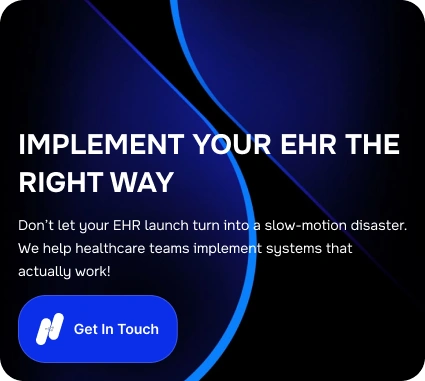May 26, 202515 min read time
EHR IMPLEMENTATION: HOW TO NOT SCREW IT UP
An EHR implementation plan isn't about plugging in software and calling it a day. It's about identifying the EHR as it seamlessly connects to your existing
XYZ
Content Manager at Hashlogics

If you're a clinic, hospital, or private practice, you probably already use some form of an EHR platform — or you're about to. The problem? It's not just about choosing a tool. It's about integrating your existing systems and workflows into that EHR in a way that doesn't break everything. That's where most teams screw up. An EHR implementation plan isn't about plugging in software and calling it a day. It's about deploying the EHR so it seamlessly connects to your existing systems — appointments, billing, patient records, labs, even your Excel sheets if that's what you've been using. Whether you're switching EHRs or starting from scratch, integration is the name of the game.
Let's break down how to do it right.
What is EHR? And What Exactly Needs to Be Implemented?
If you're a clinic, hospital, or private practice, you probably already use some form of an EHR platform — or you're about to. The problem? It's not just about choosing a tool. It's about integrating your existing systems and workflows into that EHR in a way that doesn't break everything. That's where most teams screw up. An EHR implementation plan isn't about plugging in software and calling it a day. It's about deploying the EHR so it seamlessly connects to your existing systems — appointments, billing, patient records, labs, even your Excel sheets if that's what you've been using. Whether you're switching EHRs or starting from scratch, integration is the name of the game.
Let's break down how to do it right.

That's what actual EHR deployment looks like:
- •Migrating data from older systems or spreadsheets
- •Syncing with appointment scheduling, billing, insurance, and communication tools
- •Automating documentation
- •Making records accessible and usable in real-time, across your staff
Let's examine the results when it's done correctly.
According to Itransition
- •89% of physicians report improved clinical outcomes thanks to EHRs.
- •94% of providers say their system makes patient records readily available at the point of care.
- •Proper EHR adoption leads to over 50% reduction in documentation errors and duplicated testing.
How Long Does EHR Implementation Take?
EHR System Complexity
The time required for EHR implementation largely depends on the complexity of your EHR system and the size of your organization. Simple systems for small practices may take 3-6 months, while complex systems for large healthcare networks can take 18-24 months or more.
Factors affecting implementation timeline include the number of locations, specialties, providers, existing systems requiring integration, and the extent of customization needed.
It's important to establish realistic timeframes and build in buffer time for unexpected challenges that inevitably arise during implementation.
Data Migration and Cleanup
Data migration is often one of the most time-consuming aspects of EHR implementation. If you plan to import patient records, you'll need to allocate sufficient time for data cleaning, mapping, and validation to ensure accuracy and completeness.
- •Patient demographics
- •Medical history
- •Allergies
- •Medications
Each data element requires careful verification. If you have to process thousands of records, this phase alone can take several months.
Customization and Configuration
Every healthcare organization has unique workflows and processes that need to be reflected in your EHR system.
- •Clinical templates and preferences
- •Integration with other systems (lab interfaces, billing, and practice management software)
Customization typically takes 2-4 months, depending on complexity. Custom interfaces between systems can add significant time to your implementation timeline.

George Phillips
Healthcare IT Strategist & Consultant of Healthcare Implementation at Hashlogics

Stay Ahead of the Curve with the Latest in AI, Tech, and Software Development
Explore our blog for expert insights, industry trends, and actionable advice that can accelerate your business and product development with AI-driven solutions.

How RPA, AI-Powered RPA, and Agentic Automation Drive the Future of Intelligent Automation
Discover how AI is transforming the software development lifecycle, from code generation to testing and deployment.

Agentic AI & LangChain: Revolutionizing Software Development
Explore the latest machine learning trends and how they're creating competitive advantages for forward-thinking companies.

Modular AI Automation with Make.com and n8n: Building Smart, Scalable Workflows
Learn the best practices for developing AI solutions that can grow with your business needs and adapt to changing requirements.

From Code to Capability: Building AI-Ready Applications with Replit and Automation Anywhere
Understand the ethical considerations in AI development and how to build responsible, transparent AI systems.